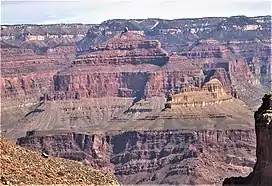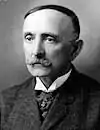| Holy Grail Temple | |
|---|---|
 Southwest aspect, with Dox Castle, seen from South Bass Trail | |
| Highest point | |
| Elevation | 6,711 ft (2,046 m)[1] |
| Prominence | 1,199 ft (365 m)[1] |
| Parent peak | King Arthur Castle (7,344 ft)[1] |
| Isolation | 2.0 mi (3.2 km)[1] |
| Coordinates | 36°16′30″N 112°18′17″W / 36.2750519°N 112.3045998°W[2] |
| Geography | |
 Holy Grail Temple Location in Arizona  Holy Grail Temple Holy Grail Temple (the United States) | |
| Location | Grand Canyon National Park Coconino County, Arizona, US |
| Parent range | Kaibab Plateau Colorado Plateau |
| Topo map | USGS King Arthur Castle |
| Geology | |
| Type of rock | sandstone, siltstone, mudstone |
| Climbing | |
| First ascent | 1977 |
| Easiest route | class 5.8 climbing[1] |
Holy Grail Temple is a 6,711-foot-elevation (2,046-meter) summit located in the Grand Canyon, in Coconino County of northern Arizona, US.[2] It is situated seven miles north-northeast of Havasupai Point, and two miles west-northwest of King Arthur Castle, within the Shinumo Amphitheater. Topographic relief is significant as it rises over 4,500 feet (1,400 meters) above the Colorado River in three miles. According to the Köppen climate classification system, Holy Grail Temple is located in a cold semi-arid climate zone, with precipitation runoff draining south to Shinumo Creek, which flows west to the Colorado River.[3]
History

Holy Grail Temple was originally named "Bass Tomb" in 1891 by Virginia Dox, for William Wallace Bass, who was Dox's guide into the Grand Canyon at this location.[4][5] Impressed by her, Bass named nearby Dox Castle shortly after she left.[6] However, at the suggestion of the U.S. Geological Survey, Bass Tomb was renamed "Holy Grail Temple", for the Holy Grail of the Legend of King Arthur, in keeping with the naming theme for other geographical features in the vicinity, e.g. King Arthur Castle, Guinevere Castle, Elaine Castle, Excalibur, Gawain Abyss, Bedivere Point, Lancelot Point, and Galahad Point.[2] This feature's present name was officially adopted in 1908 by the U.S. Board on Geographic Names.[2]
When William W. Bass died in 1933, his ashes were scattered by plane atop this mountain as per his wishes.[5] Bass Canyon and the Bass Trails still retain his name within the Grand Canyon.
The difficult first ascent of the summit was made in 1977 by Larry Treiber and Bruce Grubbs.[7]

Geology
The summit spire is composed of cream-colored Permian Coconino Sandstone. This sandstone, which is the third-youngest stratum in the Grand Canyon, was deposited 265 million years ago as sand dunes. Below the Coconino Sandstone is slope-forming, Permian Hermit Formation, which in turn overlays the Pennsylvanian-Permian Supai Group. Further down are strata of the cliff-forming Mississippian Redwall Limestone, Cambrian Tonto Group, and finally Proterozoic Unkar Group at creek level.[8]
The actual small-spire summit is a capstone of Coconino Sandstone, on a small slope of Hermit Formation. This summit sits upon an extensive shelf of the Supai Group, specifically the highly resistant, and thick in western Grand Canyon, Esplanade Sandstone.

See also
References
- 1 2 3 4 5 "Holy Grail Temple – 6,711' AZ". Lists of John. Retrieved December 26, 2020.
- 1 2 3 4 "Holy Grail Temple". Geographic Names Information System. United States Geological Survey, United States Department of the Interior. Retrieved 2020-12-26.
- ↑ Peel, M. C.; Finlayson, B. L.; McMahon, T. A. (2007). "Updated world map of the Köppen−Geiger climate classification". Hydrol. Earth Syst. Sci. 11. ISSN 1027-5606.
- ↑ Randy Moore and Kara Felicia Witt, The Grand Canyon: An Encyclopedia of Geography, History, and Culture, 2018, ABC-CLIO Publisher, page 99.
- 1 2 Gregory McNamee, Grand Canyon Place Names, 1997, Mountaineers Publisher, ISBN 9780898865332, page 64.
- ↑ Lauren A. Wright and Bennie W. Troxel, Levi Noble: Geologist, 2002, USGS, page 8.
- ↑ John Annerino, Hiking the Grand Canyon, 2017, Simon & Schuster, ISBN 9781510714984, page 79.
- ↑ N.H. Darton, Story of the Grand Canyon of Arizona, 1917, page 69.

"Chasm of the Colorado" (1873–74), a large canvas measuring 7 feet high by 12 feet wide, hung prominently in the US Capitol for over a half-century.
External links
- Weather forecast: National Weather Service
- William Wallace Bass: Kaibab.org
- William Bass photo: Wikimedia
- Holy Grail Temple from Lancelot Point photo by Harvey Butchart